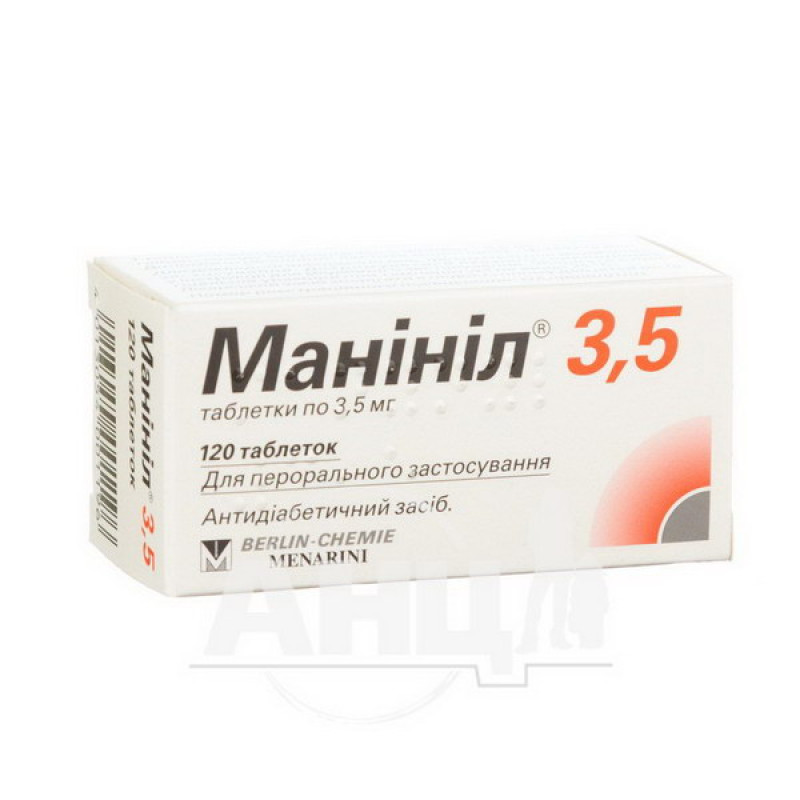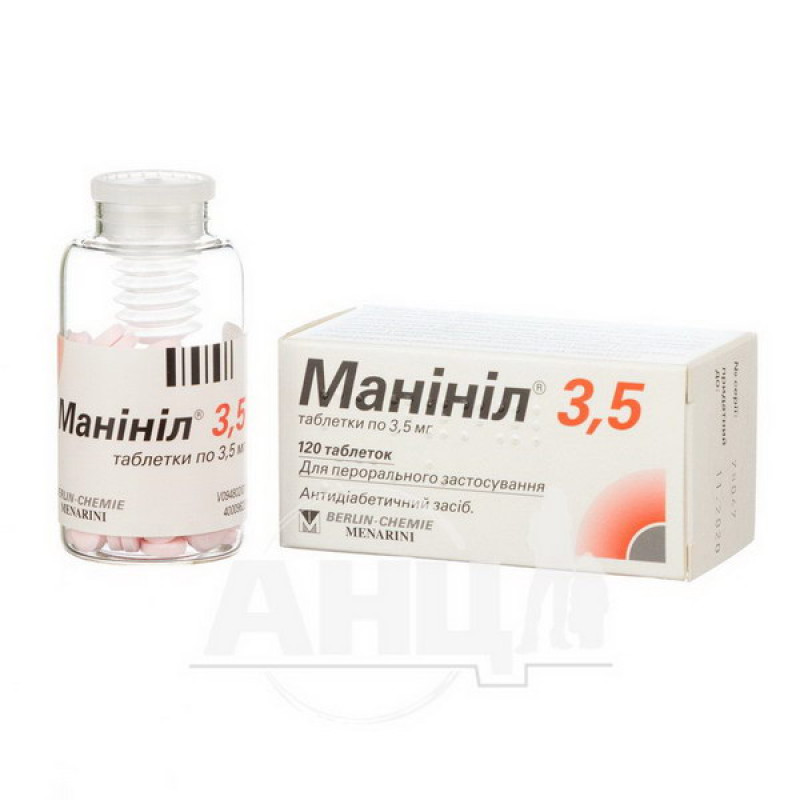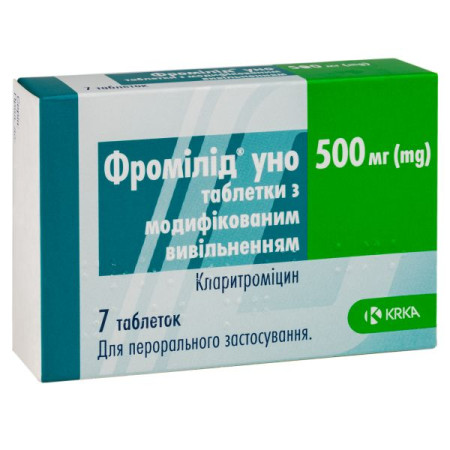Maninil 3.5 tablets 3.5 mg No. 120

Pharmacological properties
Pharmacodynamics. Glibenclamide has a hypoglycemic effect both in patients with type 2 diabetes and in healthy people, as it increases insulin secretion by pancreatic β-cells due to their stimulation. This effect depends on the concentration of glucose in the environment surrounding the β-cells.
Pharmacokinetics. After oral administration, glibenclamide is rapidly and almost completely absorbed. Simultaneous food intake does not significantly affect the absorption of glibenclamide. Binding to plasma proteins is 98%. C max in serum is reached after 1-2 hours when using Manin 3.5 and after 2.5 hours when using Manin 5 and is 100 ng / ml. After 8-10 hours, the serum concentration decreases depending on the dose administered by 5-10 ng / ml when using Manin 3.5 and by 10-20 ng / ml when using Manin 5. T ½ after IV administration is 2 hours, after oral administration of Manin 3.5 - 2-5 hours and 7 hours when using Manin 5. However, some studies indicate that this time in patients with diabetes mellitus may increase to 8-10 hours. In the liver, glibenclamide is almost completely transformed into several metabolites that do not play a significant role in the hypoglycemic action of glibenclamide. The metabolites are completely excreted from the body in equal amounts with urine and bile within 45-72 hours. In patients with impaired liver function, the elimination of glibenclamide from the blood plasma is slowed down. In renal failure, depending on the degree of renal dysfunction, the excretion of metabolites in the urine increases compensatorily. In moderate renal failure (creatinine clearance ≥30 ml/min), the total elimination remains unchanged; in severe renal failure, cumulation is possible.
Indication
Insulin-dependent diabetes in adults (type 2 diabetes mellitus), if other measures, such as strict adherence to a diet, weight loss, and sufficient physical activity, have not led to satisfactory correction of blood glucose levels.
Application
The drug is prescribed by a doctor. Diet correction is mandatory. Dosage depends on the results of blood and urine glucose tests. Tablets should be taken before meals, without chewing, with sufficient liquid (preferably 1 glass of water). When prescribing a dose of more than 2 tablets of the drug per day, it is recommended to divide the entire number of tablets (doses) into one dose in the morning and one in the evening in a ratio of 2: 1. It is very important to use the drug at the same time each time. If the patient misses one dose, it can never be compensated by taking a higher dose in the next dose. The duration of treatment depends on the course of the disease. During treatment, regular monitoring of the metabolic state is necessary.
Therapy is started, if possible, with minimal doses, especially in patients with an increased tendency to hypoglycemia and a body weight of 50 kg. It is advisable to start therapy with ½-1 tablet of Manin 3.5 (1.75-3.5 mg of glibenclamide) or ½-1 tablet of Manin 5 (2.5-5 mg of glibenclamide) once a day. If the metabolism is not corrected sufficiently, the dose is gradually increased with an interval of several days to 1 week until the required therapeutic dose is reached, which is 15 mg/day (3 tablets of Manin 5) or 10.5 mg of micronized glibenclamide (3 tablets of Manin 3.5).
Transferring a patient from other antidiabetic drugs. Transferring to Manin is carried out very carefully and starts with ½-1 tablet of Manin 3.5 (1.75-3.5 mg of glibenclamide per day) or ½-1 tablet of Manin 5 (2.5-5 mg of glibenclamide per day).
Dose selection. In elderly patients, asthenic patients or with malnutrition, as well as in renal or hepatic impairment, the initial and maintenance dose should be reduced due to the risk of hypoglycemia. In addition, if the patient's body weight decreases or if lifestyle changes occur, the dose should be adjusted.
Method of administration and duration of therapy. Tablets should be taken before meals, without chewing, with sufficient liquid (preferably a glass of water). The daily dose, which is no more than 2 tablets of the drug, should be taken before breakfast. With a daily dose of more than 2 tablets of the drug, it is recommended to divide the entire amount into one morning and one evening dose in a ratio of 2: 1. It is very important to use the drug each time at the same time. If the patient misses one dose, this can never be compensated by taking a higher dose. The duration of treatment depends on the course of the disease. During treatment, it is necessary to regularly monitor the level of glucose in blood plasma and urine; it is recommended to additionally determine the level of glycosylated hemoglobin (HbA1c) and / or fructosamine, as well as other indicators (for example, the level of lipids in the blood).
Children: Do not use glibenclamide in children.
Contraindication
Hypersensitivity to the active substance, to Ponceau 4R or any component of the drug. Hypersensitivity to other sulfonylurea drugs, sulfonamides, diuretics, sulfonamide derivatives and probenecid - cross-reactions are possible. Insulin-dependent diabetes mellitus (type I), complete secondary ineffectiveness of glibenclamide therapy in type II diabetes mellitus, metabolic acidosis, diabetic precoma or coma, condition after pancreatic resection. Severe liver dysfunction. Severe kidney dysfunction. Pregnancy and breastfeeding. Concomitant use with bosentan.
Side effects
Metabolic and nutritional disorders. Weight gain, hypoglycemia, which can be prolonged and lead to severe hypoglycemia with coma, which threatens the patient's life. In the case of an erased course of hypoglycemia, with autonomic neuropathy or concomitant therapy with sympatholytic agents, typical symptoms-precursors of hypoglycemia may be weakened or absent. Symptoms-precursors of hypoglycemia are sudden sweating, palpitations, tremor, feeling of hunger, anxiety, a feeling of crawling in the oral cavity, pale skin, headache, drowsiness, sleep disorders, a feeling of fear, unsteadiness of movements, reversible neurological symptoms (for example, speech and vision disorders, phenomena of paralysis or sensitivity disorders).
On the part of the organ of vision: visual and accommodation disorders, especially at the beginning of treatment.
Gastrointestinal tract. Nausea, feeling of fullness/bloating in the stomach, vomiting, abdominal pain, diarrhea, belching, metallic taste in the mouth. These complaints are temporary and generally do not require discontinuation of the drug.
Liver and gallbladder: Transient elevations of AST and ALT, GLP, drug-induced hepatitis, intrahepatic cholestasis, possibly due to an allergic reaction of the hyperergic type of liver cells. These disorders are reversible after discontinuation of the drug, but can lead to life-threatening liver failure.
Skin and subcutaneous tissue disorders: Pruritus, urticaria, erythema nodosum, bullous or maculopapular rash, purpura, photosensitivity. These hypersensitivity reactions are reversible, but very rarely can develop into life-threatening conditions, accompanied by shortness of breath and a significant decrease in blood pressure, up to the development of shock. Hypersensitivity reactions, including rash, arthralgia, fever, proteinuria and jaundice; allergic vasculitis, are life-threatening. If skin reactions occur, you should consult a doctor.
From the side of the blood and lymphatic system. Thrombocytopenia, leukopenia, erythropenia, granulocytopenia up to the development of agranulocytosis, aplastic anemia, eosinophilia. In some cases: pancytopenia, hemolytic anemia. These changes in the blood picture are reversible after drug withdrawal, but very rarely can be life-threatening.
Other side effects: Weak diuretic effect, reversible proteinuria, hyponatremia, disulfiram-like reaction, cross-allergy with sulfonamides, sulfonamide derivatives and probenecid, syndrome of inappropriate antidiuretic hormone secretion. Ponceau 4R may cause allergic reactions.
Special instructions
It should be remembered that the simultaneous use of Manin with clonidine, β-adrenergic blockers, guanethidine and reserpine may impair the patient's perception of symptoms - precursors of hypoglycemia.
Special caution is required in cases of impaired renal or hepatic function, decreased thyroid, pituitary or adrenal function.
Alcohol, when consumed in large quantities once and with its constant use, can unpredictably enhance or weaken the effect of Manin. Constant abuse of laxatives can lead to a deterioration in metabolism. If the treatment regimen is not followed, the hypoglycemic effect of the drug is insufficient, or during stressful situations, the level of glucose in the blood plasma may increase. Symptoms of hyperglycemia: polydipsia, dry mouth, frequent urination, itching and dry skin, fungal or infectious skin diseases, decreased performance. In severe stressful situations (trauma, surgery, infectious disease accompanied by an increase in body temperature), metabolism may deteriorate, leading to hyperglycemia, sometimes so severe that it may be necessary to temporarily transfer the patient to insulin therapy. The patient should be informed that the development of other diseases during treatment with Maninil should be immediately reported to the doctor.
In patients with glucose-6-phosphate dehydrogenase deficiency, treatment with sulfonylurea drugs, including glibenclamide, may cause hemolytic anemia, so it is necessary to decide on their transfer to drugs alternative to sulfonylurea derivatives. Maninil should not be used in patients with hereditary galactose intolerance, lactase deficiency or glucose-galactose malabsorption syndrome.
Use during pregnancy and breastfeeding. Glibenclamide is contraindicated.
If possible, oral hypoglycemic therapy should be postponed before planning pregnancy. Insulin control of diabetes is the treatment of choice during pregnancy or breastfeeding.
Ability to influence the reaction rate when driving vehicles or working with mechanisms. Hypoglycemia may reduce the ability to concentrate and react, which must be taken into account and safety measures must be taken to eliminate hypoglycemia when driving vehicles and working with other mechanisms. This is especially important in cases of frequent occurrence of hypoglycemic states or lack of adequate perception of symptoms - precursors of hypoglycemia, in which case it is necessary to decide on the appropriateness of driving vehicles.
Interactions
When using Manin simultaneously with other medications, its effect may be enhanced or weakened, so it is necessary to consult a doctor regarding the use of other medications.
The effect of glibenclamide may be enhanced (hypoglycemic states may develop) when used simultaneously with other oral antidiabetic drugs and insulin, ACE inhibitors, anabolic steroids and male sex hormone preparations, antidepressants (fluoxetine, MAO inhibitors), β-adrenergic blockers, quinolone derivatives, chloramphenicol, clofibrate and its analogues, coumarin derivatives, disopyramide, fenfluramine, miconazole, PAS, pentoxifylline (when administered parenterally in high doses), perhexiline, pyrazolone derivatives, probenecid, salicylates, sulfonamides, tetracycline drugs, tritoqualine, and cytostatics of the cyclophosphamide group. Taking β-adrenergic blockers, clonidine, guanethidine, and reserpine may reduce the perception of early symptoms of hypoglycemia.
A decrease in the effect of glibenclamide (possible development of hyperglycemic reactions) may occur with simultaneous use with acetazolamide, β-adrenergic blockers, barbiturates, diazoxide, diuretics, glucagon, isoniazid, corticosteroids, nicotinate, phenothiazine derivatives, phenytoin, rifampicin, thyroid hormones, female sex hormone preparations (gestagens, estrogens), sympathomimetics.
H2-receptor blockers, clonidine and reserpine can both weaken and enhance the hypoglycemic effect of drugs. In some cases, pentamidine can lead to severe hypo- or hyperglycemia. The effect of coumarin derivatives can both strengthen and weaken.
Bosentan. An increased incidence of liver enzyme elevations has been observed in patients receiving glibenclamide concomitantly with bosentan. Both glibenclamide and bosentan inhibit the function of the pump that removes bile salts from the cell. This leads to intracellular accumulation of bile salts, which have cytotoxic effects, and this combination should therefore not be used.
Overdose
Symptoms of overdose (hypoglycemia): sudden hyperhidrosis, increased heartbeat, tremor, feeling of hunger, anxiety, paresthesias in the mouth, pale skin, headache, drowsiness, sleep disturbances, fearfulness, unsteadiness of movements, reversible neurological deficit (impaired speech and vision, the appearance of paralysis or impaired sensitivity). With progressive hypoglycemia, loss of consciousness is possible (hypoglycemic coma). In such cases, the skin is moist and cold to the touch, tachycardia, hyperthermia, motor excitement, hyperreflexia, paresis and a positive Babinski reflex are noted, convulsions may occur.
Treatment: Mild to moderate hypoglycemia can be treated by the patient by taking sugar or a carbohydrate-rich meal. Therefore, they should always carry 20 g of glucose with them. Patients should inform their doctor when hypoglycemia occurs so that the dose can be adjusted if necessary. In case of severe hypoglycemia, they should seek medical attention immediately.
In case of accidental overdose and in case of contact with the patient, it is necessary to induce vomiting, perform gastric lavage (in the absence of convulsive readiness) and in / in administer glucose solution. If the patient has lost consciousness, it is necessary to immediately begin intravenous administration of glucose (bolus 40-80 ml of 40% glucose solution followed by infusion of 5-10% glucose solution). If necessary, 1 mg of glucagon can be additionally administered intramuscularly or intravenously. If the patient does not regain consciousness, the above measures are repeated, if necessary, intensive therapy is carried out. With prolonged hypoglycemia, monitoring of the patient's condition is required with regular monitoring of glycemia for several days and, if necessary, infusion therapy.
Storage conditions
In the original packaging at a temperature below 25 °C.
There are no reviews for this product.
There are no reviews for this product, be the first to leave your review.
No questions about this product, be the first and ask your question.








